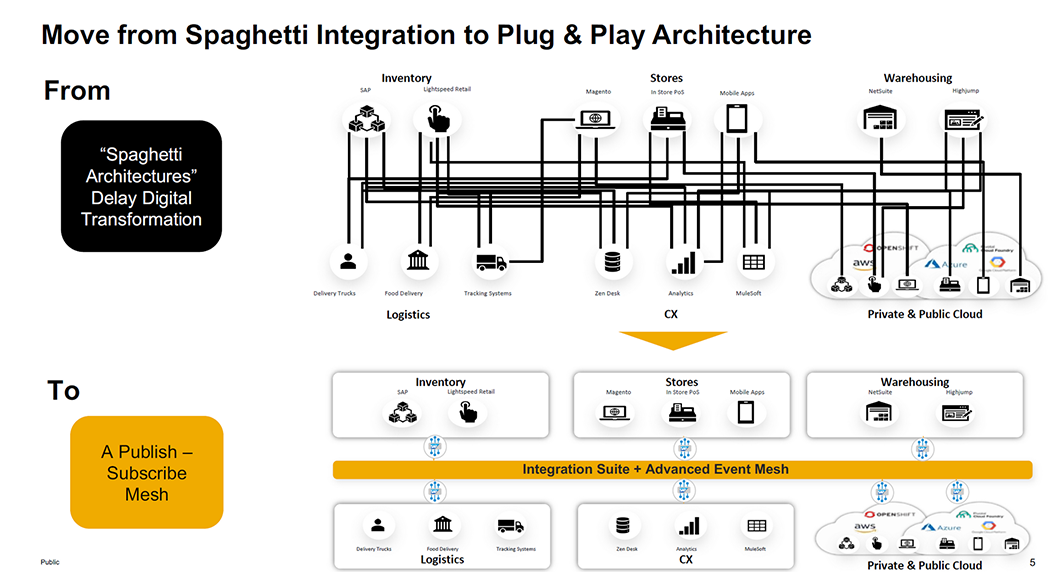Event-Driven Architecture - From Monolith to Networked Cloud Solution
The transition from a monolithic system to a networked cloud solution requires an architectural shift from outdated "spaghetti interfaces" that connect systems on a 1:1 basis to flexible plug-and-play integrations that enable real-time communication and can be expanded flexibly.
The transformation from a monolithic ERP system to a network of cloud solutions is in full swing. Instead of a single ERP system in the basement, you will have a variety of hybrid solutions in the future that need to be integrated. The number of interfaces is increasing, and so is the complexity. The transition from ECC to SAP S/4HANA and cloud solutions is not an easy process. Often, a parallel operation is required, where ECC, SAP S/4HANA, and various cloud solutions run concurrently because not all business units can be switched over simultaneously. This requires flexible activation and deactivation of interfaces for each organizational unit and solution on both the sender and receiver sides. It may also be necessary to operate the interfaces in parallel, and additional message recipients may need to be added during the project. Tightly coupled interfaces, such as IDocs, which require changes on both sides, cause significant transition effort. Both the software architecture and application design play a key role in solving this issue. With an event-driven architecture (EDA), such as the one offered by SAP Event Mesh, you can implement real-time communication requirements for the future. The decoupling of communication, conducted asynchronously between publishers and subscribers, leads to a loose coupling that promises greater agility.
What is an Event-Driven Architecture (EDA)?
An event-driven architecture (EDA) is an integration model for publishing, capturing, processing, and responding to events in distributed systems in real time. When an event occurs in one application, a message is automatically sent to all other applications that need to be aware of it, allowing them to react accordingly.
Event-based architectures are decoupled, meaning the applications do not need to know each other to exchange information and perform tasks. Event information or messages can flow freely and automatically between applications. Therefore, the EDA model is much faster than the traditional request/response model, where one application requests specific information from another and waits for a response before proceeding with the next task. Due to the decoupled nature of EDA, it is widely regarded as a best practice for microservices communication.
How does EDA Differ from Traditional Architectural Approaches like Monolithic or Service-Oriented Architectures (SOA)?
Event-driven architecture (EDA) differs in several key aspects from traditional architectural approaches like monolithic or service-oriented architectures (SOA). Here are some main differences:
Monolithic Architectures:
• Centralized: Monolithic systems are centralized units where all functions are integrated into a single application.
• Coupling: They have strong coupling, meaning the components are closely linked, and changes in one place can have far-reaching effects.
• Scaling: Scaling involves copying the entire monolith onto multiple servers, which can lead to resource inefficiency.
Service-Oriented Architectures (SOA):
• Service-Based: SOA consists of various services that fulfill specific business functions and communicate with each other through network calls.
• Loose Coupling: The services are typically loosely coupled, meaning they are more independent of each other and can be more easily updated or replaced.
• Synchrony: Communication in SOA is often synchronous, which can lead to delays when one service waits for a response from another.
Event-Driven Architectures (EDA):
• Asynchrony: EDA is based on asynchronous communication, where services do not have to wait for responses and can act independently.
• Reactivity: Components in EDA respond to events, allowing for quicker and more flexible reactions to changes.
• Scalability: EDA enables more efficient scaling as only the components that require more resources due to event volume need to be scaled.
To summarize, EDA offers greater flexibility, better scalability and a more efficient response to business events compared to monolithic and SOA architectures. These characteristics make EDA particularly suitable for modern, distributed systems that require rapid adaptation to changing requirements.

